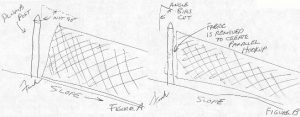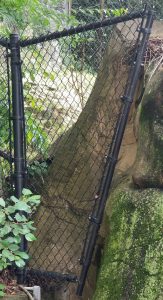How to Stretch Chain Link Fence with a Bias Cut
When woven, chain link fence fabric is ‘square’ meaning sides are perpendicular to each other and a roll of chain link is indeed a rectangle when unrolled and laid out. A problem arises when setting chain link fence posts, framing top rail, and stretching chain link fence mesh as landscapes and terrains are rarely flat, level, or even straight. Experienced fence contractors will have the wisdom to raise and lower posts to accommodate grade changes, however sharp slopes of terrain will leave the top, or bottom of the fence loose. To accommodate sharp slopes, the chain link fence fence fabric can be bias cut to shorten either the top, or bottom of the fabric in width, allowing it to be stretched tight.

Essentially, one will need to layout chain link fence fabric across top rail of fence. This is the constant for a good looking chain link fence installation. Side ends and even the bottom can always be cut to fit, however the top rail is one of the most noticeable parts which will show a poor fit chain link fence. After lining up the chain link fence fabric to top rail, tie it off to hold in place. Estimate how many links, or chain link pickets that may need cut. Removing 2 or three pickets in even increments, ‘stair-steps’ down the length of the fence is frequent. Cutting out more chain link pickets than this is a significant bias cut. Once cut, you may find bending the remaining fence link slightly to help hold in place helpful. Next, slide 3/16″ x 5/8″ (or 3/4″) tension bar in at angle. Take care to force tension bar at appropriate angle and catch each transition point in the fence. You may find tension bar to be short since you now need a longer length at an angle versus run straight. Use a longer one, or cut two to overlap if necessary and you have an extra. Tension bars for chain link fence can be overlapped to make longer. Last, connect chain link fabric and tension bar to fence terminal post with 5/16″ x 1-1/4″ galvanized carriage bolts and nuts and appropriate-sized chain link fence post fittings. Use aluminum or galvanized steel chain link tie wires to secure chain link fence to frame.
Some stretches of chain link fence fabric will have a bias cut on one end only. More rare, but possible, are stretches of chain link fence that require a bias cut on both ends; these are often shorter stretches where the tightness, or looseness won’t be spread out over a longer stretch of fence. Repeat steps on other end if necessary until all slack is removed. Check out our complete How to Install Chain Link Fence Manual here.
